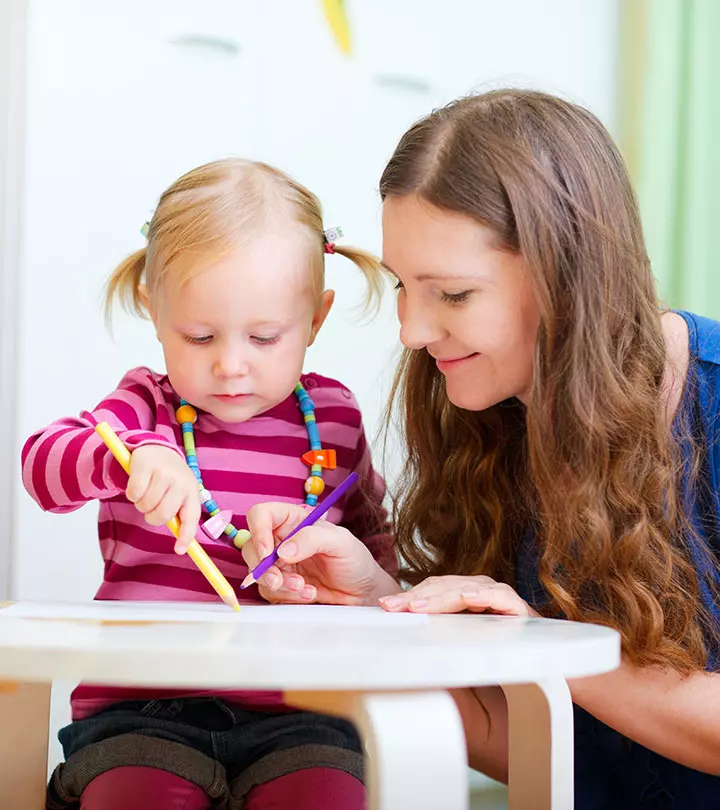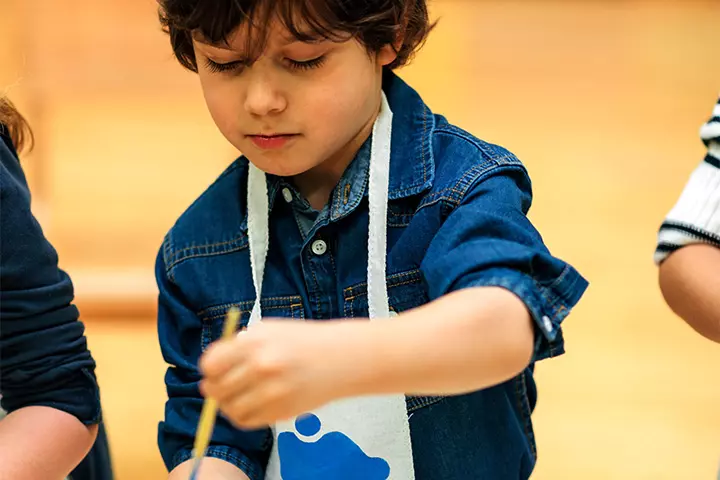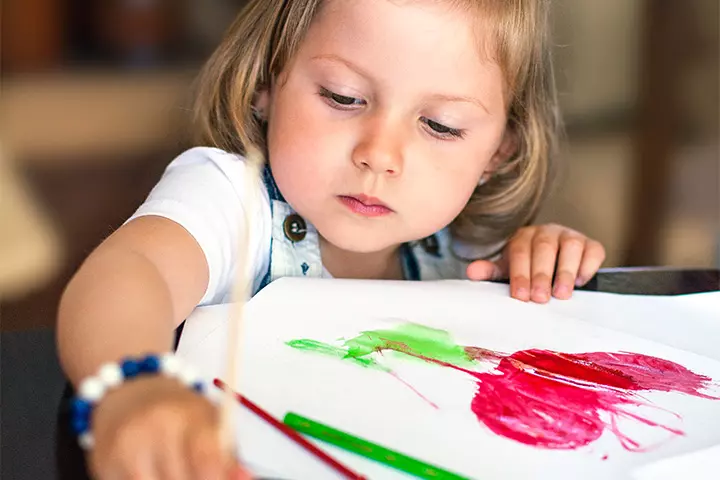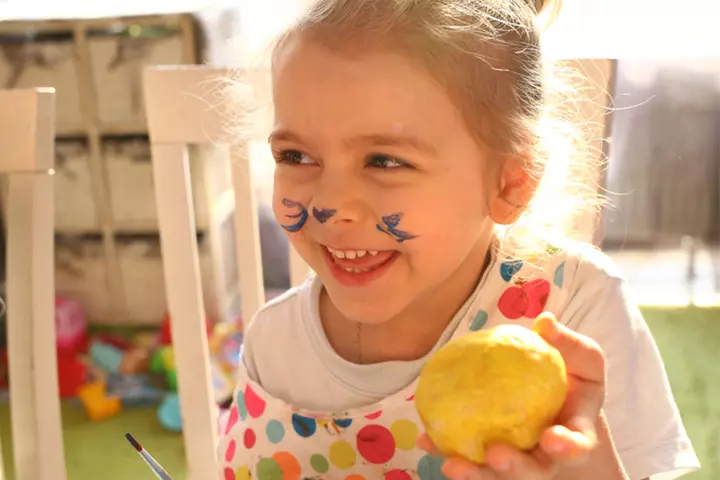
Image: Shutterstock

Drawing and coloring are all-time favorite activities of most children. What if we tell you that you can use coloring pages for your child’s development? Coloring provides a medium through which children can learn to express themselves or showcase their creativity. This simple and fun activity may also improve motor skills and give your child the pleasure of creating artwork. Continue reading this post that takes you through the benefits of coloring and how it may aid your child’s development.
14 Advantages Of Children Coloring Pages
Coloring books and sheets are important educational tools to prepare the preschoolers for school.
It is also one of the most favorite pastime activities of the kids. It sparks their imagination and gives them an opportunity to express themselves. Give your kids drawing sheets of their favorite cartoons, animals or film stars; they will spend hours coloring it.
Here are some benefits of colouring worksheets for kids:
1. Handwriting

Image: IStock
Children need hand strength and dexterity to manipulate a pencil on a paper. Working on strength can eliminate the possibility of incorrect pencil grasp.
Activities like children colouring pages and sheets will help them to hold the writing tool the correct way. This will improve your children’s handwriting.
2. Hand and eye coordination
The basic coordination skills like the proper way of holding the crayons, sharpening the crayons and recognizing what color to use, can help your children greatly.
Coloring diagrams require your kids to color within the specified area. This helps to develop hand and eye coordination in kids. It also fights cognitive loss, especially if you choose challenging and difficult drawing sheets.
 Did you know?
Did you know?3. Relaxation and patience
Coloring can help your children to learn the skill of patience. It allows your children to be relaxed and comfortable while creating a piece of art.
Children can color the shapes and figures anyway they like. It also gives your kids a sense of accomplishment when he finishes coloring a page.
4. Focus

Image: IStock
Focus is one important lesson that your children can learn from coloring. It has been proven that children who spend their time coloring have better concentration and focus skills. Coloring activates your frontal lobe, so your brain is problem-solving and organizing as you color.
As your child grows older, he also learns the importance of boundaries in the coloring worksheets for kids. The exposure to boundaries will be a great help while learning to write.
5. Knowledge
Coloring a picture can help your children to recognize line, perspective, color, hue, shape and form. Your children also learn to recognize patterns.
This, eventually, aids your children to decide on what colors he will use in their next picture.
6. Confidence
Regular coloring also improves confidence in your young kids.
Completing a coloring sheet gives your kids a sense of accomplishment, which builds their self-esteem and confidence.
7. Motor skills
The act of coloring can improve motor skills in your children. The motions involved in coloring like holding the tools and scribbling with crayons can help in the development of the tiny muscles in his wrist, fingers and hands. Fine motor skills help your children to write and manipulate small objects. This helps your children to perform better academically.
Coloring helps to develop and strengthen the hand muscles, which later helps with activities like typing and lifting objects.
A short study also indicated that skillful use of hands while coloring and drawing helps improve fine muscles. For example, in the first graph below, out of 11 children, the majority scored low on the ability to hold stationery, move hands, or color. But after the teacher taught them how to paint and the children engaged in some drawing activities, their fine motor skills showed tremendous improvement, as seen in graph 2.

Effects of drawing on fine motor skills in children
Source: Fine Motor Stimulation of children Through Coloring Activities in Early Childhood; ResearchGate/Jurnal Pemikiran dan Penelitian Pendidikan Anak Usia DiniSource: Fine Motor Stimulation of children Through Coloring Activities in Early Childhood; ResearchGate/Jurnal Pemikiran dan Penelitian Pendidikan Anak Usia Dini
8. Creativity

Image: IStock
Coloring gives your kids an opportunity to express their creative side. A child makes an imaginary world in his mind before drawing the picture on the sheet. So, hand your kids a box of crayons and set them free. This can lead to many highly desired outcomes. It allows your children to think about the different color combinations that he or she can use to give an appealing look to the picture.
Do not fret if your kids are not coloring properly or if he is coloring outside the lines. Praise them for his effort. If you see your kids making mistakes while coloring, help them with it instead of chiding. Teach him how to fill a space and do up and down strokes. You can also teach him to use complementary colors to make the picture appear more vibrant. Coloring is also an excellent medium of expression. Children often express their personality through drawing and coloring.
 Point to consider
Point to consider9. Self-expression
Some children like to express themselves through words, while some use the form art. You can tell a lot about a person by the colors he uses and the image he draws.
If a child draws disturbing images, such as a skull, they need your help urgently. If they draw the sun, hearts, and other cheerful objects, they may be expressing content and satisfaction.
10. Color recognition

Image: Shutterstock
Children receive their first exposure to the color wheel by crayons, colored pencils and markers. They learn to tell the difference between green, yellow, red, pink and so on. Using different colors gives your children a chance to explore the different color combinations.
It also teaches your children about lesser known colors. Children who learn early about color wheel have an easier time understanding the makeup and mixing of colors.
11. Therapeutic
Coloring is proven therapeutic for some kids, especially if they do it frequently. They vent their feelings, frustrations and other emotions through coloring. It relaxes the fear center of your brain and can induce the same state as meditating.
An angry child vents out his frustration by scribbling over the picture of the sun or outside the lines.
12. Grip

Image: IStock
For many kids, crayon is the first object that they learn to hold in a certain manner. It is very important for your children to have proper grip and control over their writing and coloring tools.
This will help them greatly to work on penmanship.
13. Language development
Coloring and just talking about it will give your kids an opportunity to learn new words and sentences. Children use descriptive words to talk about their feelings when they see different styles of coloring sheets. Children coloring pages aids in developing their critical thinking ability.
14. Social skills
Coloring pages can act as a means to develop the social skills of your child. Give children coloring pages on outings and playdates and watch them communicate with each other and come up with unique ideas. They can also help children learn the importance of sharing and respecting each other’s space and ideas.
Frequently Asked Questions
1. At what age should a child start coloring in the lines?
A child may be able to color inside lines by three to five years of age, although this is not fixed and may vary from one child to another. Never force your child to color inside the lines if they find it difficult or do not want to do it, irrespective of their age.
2. What coloring skill should I teach first?
You may start by teaching them to hold crayons and guide their hand on paper. Thicker crayons are also available for easy gripping of young children. Initially, allow them to scribble and draw large lines with color.
3. Is coloring a sensory activity?
Yes, coloring is a sensory activity as it involves hand-eye coordination and visual perception.
4. What kind of coloring books do children like?
Children’s liking for coloring books varies as they grow. While young children may be attracted to big and brightly colored patterns, older children may prefer more complex designs. You may even consider geometric coloring pages or emotions coloring pages for older children.
5. How can I encourage my child to start coloring?
You can encourage your child to start coloring by providing attractive materials that are fun to handle. If your child is young, start with simple shapes before proceeding to complex ones. Praise their work and make the coloring sessions interactive. You can also give them prints of their favorite cartoon characters or objects.
6. What types of coloring materials are best for young children?
Non-toxic and washable crayons and markers are best for children. Some crayons come in different shapes that allow children to grip them easily. You may also introduce colored pencils if they can hold pencils easily. For younger children, finger paints or watercolors are perfect.
7. What are some tips for instilling a love of coloring in my children?
Set aside a specific time each day for coloring, as children love routines—they will look forward to doing this activity. Also, take part in the activity and make it a bonding activity. You may also create a well-lit coloring corner with all the materials in place for them.
Most children are interested in art. They spend a lot of time drawing and coloring. There are various benefits of coloring pages for your child’s development. Going through the list, you will understand that apart from enhancing the creativity and imagination of a child, coloring pages also improve handwriting, increase focus, build hand-eye coordination, and help in many other ways. So, let your child spend time drawing and coloring. The activity will prepare them for the future and help them learn many different skills.
Infographic: Benefits Of Coloring Pages For Children
Coloring and drawing are more than just engaging and enjoyable activities for children. They boost a child’s development and bring their artistic skills to the fore. So, check out the infographic below to learn how coloring pages support your child’s development.
Some thing wrong with infographic shortcode. please verify shortcode syntax
Key Pointers
- Coloring helps children relax, teaches them patience, and provides a sense of accomplishment upon completing a page.
- Coloring pages help improve a child’s handwriting by strengthening hand muscles and teaching correct pencil grasp.
- Hand-eye coordination is developed as children learn to color within specific boundaries and handle tools like crayons.
- Children gain knowledge of lines, shapes, colors, and patterns, which enhances their ability to make decisions about how they use colors in the future.
References
- Association for Psychological Science; Study Links Children’s Eye-Hand Coordination with Their Academic Performance (2018)
https://www.psychologicalscience.org/news/releases/study-links-childrens-eye-hand-coordination-with-their-academic-performance.html
Community Experiences
Join the conversation and become a part of our nurturing community! Share your stories, experiences, and insights to connect with fellow parents.
Read full bio of Dr. Holly Schiff
Read full bio of Arshi Ahmed
Read full bio of Rohit Garoo
Read full bio of Trisha Chakraborty
















